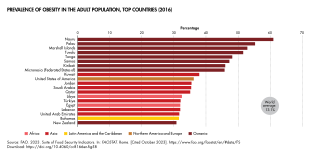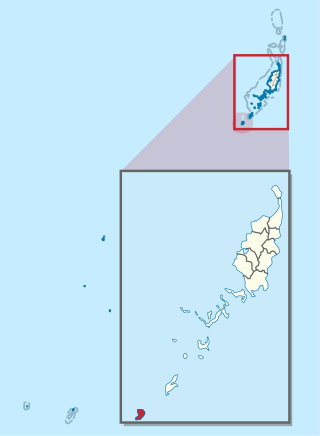Notable people
| Lists of Americans |
|---|
| By US state |
| By ethnicity or nationality |
| Total population | |
|---|---|
| 7,450 (2010 Census) [1] | |
| Regions with significant populations | |
| California | |
| Languages | |
| American English, Palauan English, Palauan, Sonsorolese, Tobian, Spanish | |
| Religion | |
| Christianity Modekngei |
Palauan Americans are Americans of Palauan descent. According to the 2010 census, there are about 7,450 Americans of Palauan origin.
Since the late 1940s, many Palauans have emigrated abroad. In 1953, about a hundred people from Palau founded the Palau Association in the American island of Guam. Over the years, the number of Palauans has continually grown.
In early 1970, when the Pell Grant was extended, several hundred Palauans and other students of Micronesia emigrated to study at American universities. Since then, the number of Palauan students emigrating to USA has increased by about 250 people every year.
Many Palauans live in California, most notably, Pasadena. Palauans also live in Portland, Oregon, where a few thousand Micronesians live, and Corsicana, Texas. [2]
| Lists of Americans |
|---|
| By US state |
| By ethnicity or nationality |

Micronesia is a subregion of Oceania, consisting of about 2,000 small islands in the Northwestern Pacific Ocean. It has a close shared cultural history with three other island regions: Maritime Southeast Asia to the west, Polynesia to the east, and Melanesia to the south—as well as with the wider community of Austronesian peoples.

Palau, officially the Republic of Palau, is an island country in the Micronesia subregion of Oceania in the western Pacific. The republic consists of approximately 340 islands and connects the western chain of the Caroline Islands with parts of the Federated States of Micronesia. It has a total area of 466 square kilometers (180 sq mi), making it one of the smallest countries in the world. The most populous island is Koror, home to the country's most populous city of the same name. The capital Ngerulmud is located on the largest island of Babeldaob, in Melekeok State. Palau shares maritime boundaries with international waters to the north, the Federated States of Micronesia to the east, Indonesia to the south, and the Philippines to the northwest.

Palau was initially settled around 1000 BC.

Demographic features of the population of Palau include population density, ethnicity, education level, health of the populace, economic status, religious affiliations and other aspects.

Pacific Islanders, Pasifika, Pasefika, Pacificans or rarely Pacificers are the peoples of the Pacific Islands. As an ethnic/racial term, it is used to describe the original peoples—inhabitants and diasporas—of any of the three major subregions of Oceania.
Palauan is a Malayo-Polynesian language native to the Republic of Palau, where it is one of the two official languages, alongside English. It is widely used in day-to-day life in the country. Palauan is not closely related to other Malayo-Polynesian languages and its exact classification within the branch is unclear.

Angaur, or Ngeaur in Palauan, is an island and state in the island nation of Palau.
The music of Palau finds its heritage in Micronesia, but it has been supplemented with influences from the United States and Western Europe, as well as Japan.
The Micronesians or Micronesian peoples are various closely related ethnic groups native to Micronesia, a region of Oceania in the Pacific Ocean. They are a part of the Austronesian ethnolinguistic group, which has an Urheimat in Taiwan.
Modekngei, or Ngara Modekngei, is a monotheistic religious movement founded around 1915 by Tamadad, a native of the island of Babeldaob, that spread throughout Palau. It rose to political significance between the First and Second World Wars and is currently professed by 5.7% of Palau's population. Modekngei is a hybrid of ancient Palauan customs and Christianity. Followers of the religion believe in the Christian God, recognize Jesus Christ as the Messiah, and simultaneously make appeasements to the traditional Palauan deities.

Pacific Islander Americans are Americans who are of Pacific Islander ancestry. For its purposes, the United States census also counts Aboriginal Australians as part of this group.

Albanian Americans are Americans of full or partial Albanian ancestry and heritage in the United States. They trace their ancestry to the territories with a large Albanian population in the Balkans and southern Europe, including Albania, Italy, Kosovo, North Macedonia and Montenegro. They are adherents of different religions and are predominantly Muslims and Christians, while some are irreligious.
Koreans in Micronesia used to form a significant population before World War II, when most of the region was ruled as the South Seas Mandate of the Empire of Japan; for example, they formed 7.3% of the population of Palau in 1943. However, after the area came under the control of the United States as the Trust Territory of the Pacific Islands, most Koreans returned to their homeland. As of 2013, about seven thousand South Korean expatriates & immigrants and Korean Americans reside in the Marianas, which have remained under U.S. control, while only around two hundred South Korean expatriates reside in the independent countries of Micronesia.
Micronesian Americans are Americans who are descended from people of the Federated States of Micronesia. According to the 2020 US Census, a total of 21,596 residents self-identified as having origins in the country, which consists of four states. More than half of these residents identified their origin as Chuuk State (12,464) with the rest as follows: 4,918 people from Pohnpei, 2,066 from Yap, and 2,148 people from Kosrae.
There is a small Japanese community in the Pacific Island country of Palau, which mainly consists of Japanese expatriates residing in Palau over a long-term basis. A few Japanese expatriates started to reside in Palau after it gained independence in 1994, and established long-term businesses in the country. Japanese settlement in Palau dates back to the early 19th century, although large scale Japanese migration to Palau did not occur until the 1920s, when Palau came under Japanese rule and administered as part of the South Seas Mandate. Japanese settlers took on leading administrative roles in the Japanese colonial government, and developed Palau's economy. After the Japanese surrender in 1945, virtually all of the Japanese population was repatriated back to Japan, although people of mixed Japanese-Palauan descent were allowed to remain behind. People of Japanese-Palauan descent constitute a large minority of Palau's population as a result of substantial intermarriage between the Japanese settlers and Palauans. They generally identify with, conforming to cultural norms and daily lives with the Palauans.
Chinese have been settling in Palau in small numbers since the 19th century. The early settlers consisted of traders and labourers, and often intermarried with Palauan women. Their offspring quickly assimilated with the local populace and generally identify themselves as Palauan. In recent years, Palau has seen a growing expatriate business community from Taiwan, after Palau established formal diplomatic ties with Taiwan in 1999.
The sport of baseball is widely played in Palau, having been introduced by the Japanese during their occupation of the island nation. The highest level of league play in Palau in represented by Palau Major League (PML), which is overseen by the Belau Baseball Federation. The country is represented in international play by the Palau national baseball team.
The Malaysian diaspora are Malaysian emigrants from Malaysia and their descendants that reside in a foreign country. Population estimates vary from seven hundred thousand to one million, both descendants of early emigrants from Malaysia, as well as more recent emigrants from Malaysia. The largest of these foreign communities are in Singapore, Australia, Brunei and the United Kingdom.

William Vincent "Vit" Vitarelli, also referred to as Rubak in Palau, was an American educator and architect. He worked for the Trust Territory of the Pacific Islands (TTPI) from 1948 to 1970. He was stationed in various islands in Micronesia, including Palau and Ebeye, and participated in various educational and community development projects.
Palauan nationality law is regulated by the 1980 Constitution of Palau, as amended; the 1994 Palau Citizenship Act, and its revisions; and international agreements entered into by the Palauan government. These laws determine who is, or is eligible to be, a national of Palau. The legal means to acquire nationality, formal legal membership in a nation, differ from the domestic relationship of rights and obligations between a national and the nation, known as citizenship. Palauan nationality is typically obtained either on the principle of jus soli, i.e. by birth in Palau or under the rules of jus sanguinis, i.e. by birth abroad to parents with Palauan nationality. It can be granted to persons with an affiliation to the country through naturalization.